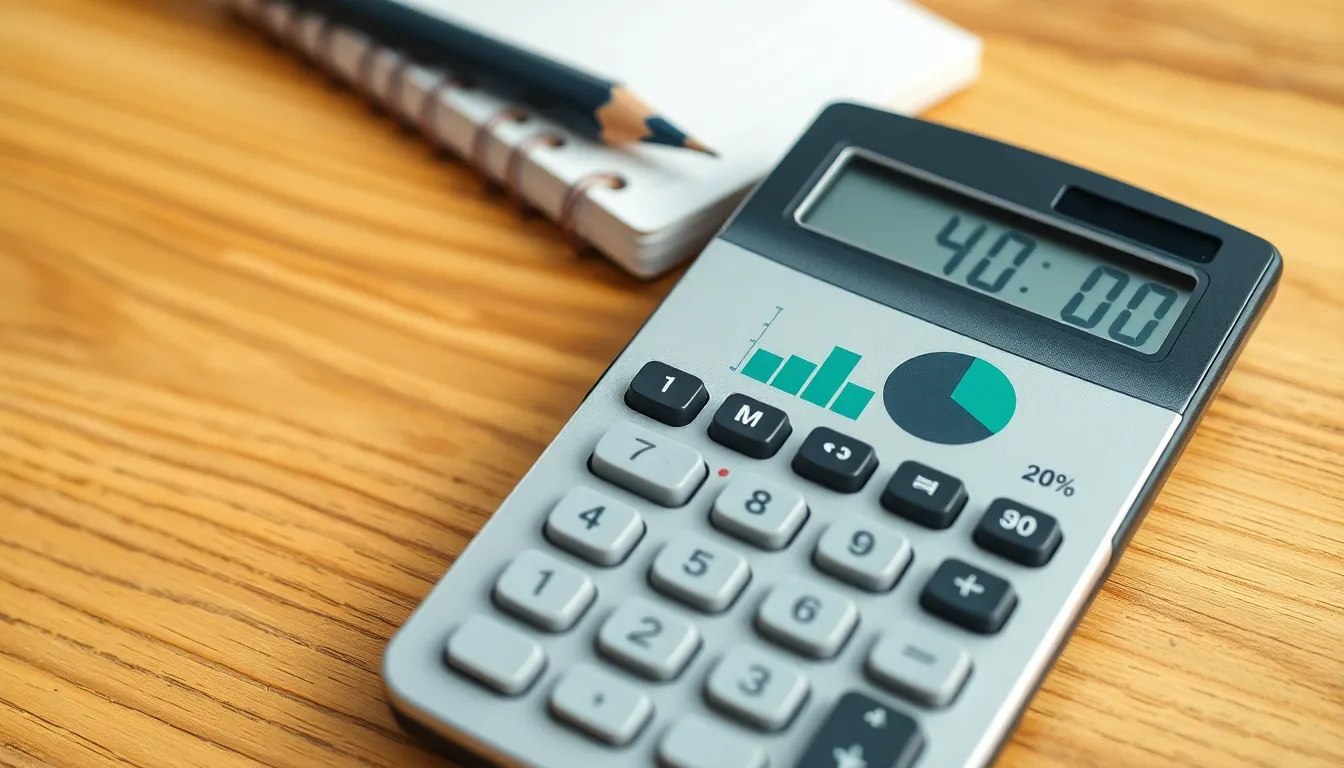Table of Contents
ToggleMath can sometimes feel like a foreign language, especially when it comes to percentages. But fear not! Understanding what 20 percent of 40 is can be as easy as pie—well, maybe not as delicious, but definitely simpler than it sounds. Whether you’re budgeting for your next pizza night or calculating a discount on those shoes you’ve been eyeing, mastering this simple math concept can save both time and money.
Understanding Percentages
Percentages represent a portion of a whole, often expressed as a fraction of 100. They provide a clear way to compare relative sizes and values in various contexts.
Definition of Percentages
A percentage indicates how much of something there is relative to the total. Typically, this figure appears as a number followed by the percent sign (%). Calculating a percentage involves dividing the part by the whole, then multiplying by 100. For example, to determine 20 percent of 40, the calculation becomes (20 divided by 100) multiplied by 40. This results in 8, making percentages a useful tool for understanding proportions.
Importance of Percentages in Daily Life
Percentages play a crucial role in everyday decisions. Budgeting, shopping discounts, and tax calculations often rely on percentage values. Understanding this concept helps consumers make informed choices. For instance, knowing that a 20 percent discount on a $40 item saves $8 aids in assessing affordability. Similarly, during financial planning, grasping percentages helps individuals allocate resources effectively. Decisions involving savings, investments, and expenses often involve percentage calculations, emphasizing their practical significance.
Calculation Breakdown

Calculating 20 percent of 40 is simple and can be approached in multiple ways. Understanding these methods provides clarity in percentage calculations.
Step-by-Step Calculation of 20 Percent of 40
First, convert the percentage to a decimal. Twenty percent equals 0.20 in decimal form. Next, multiply this decimal by 40. The calculation becomes 0.20 x 40. This results in an answer of 8. Thus, twenty percent of 40 equals 8.
Alternative Methods to Calculate Percentages
Calculators offer a quick alternative for finding percentages. Enter 40, then multiply by 20 and divide by 100 to find the same result. A visual approach involves understanding fractions. Recognizing that 20 percent is one-fifth, dividing 40 by 5 also leads to 8. Each method confirms the answer consistently.
Real-Life Applications
Understanding percentages, such as calculating 20 percent of 40, plays a significant role in daily scenarios. Many practical examples highlight how this knowledge is useful in real life.
Practical Examples of 20 Percent
Calculating 20 percent can simplify everyday financial decisions. For instance, if someone budgets for groceries totaling $40, knowing 20 percent equals $8 allows them to set aside money for essentials. Similarly, when a student needs to score at least 20 percent on a project worth 40 points, realizing this equates to 8 points clarifies the effort they need to make. Additionally, during a sale, if an item priced at $40 offers a 20 percent discount, the immediate saving of $8 clarifies the sale’s value to the shopper.
How Percentages Affect Pricing and Discounts
Pricing strategies heavily rely on percentages. Retailers often apply a 20 percent markdown to attract customers, significantly increasing the shopper’s interest. If an item originally costs $40, applying a 20 percent discount drops the price to $32. This percentage not only affects consumer perception but also influences purchasing decisions. Many consumers feel more inclined to buy when they perceive solid discounts. Discussions about budget allocations and cost evaluations benefit from this understanding, helping individuals make informed choices in shopping and financial planning.
Common Mistakes
Many individuals make errors when calculating percentages. Misunderstandings often stem from confusing percentages with fractions. A common belief is that calculating 20 percent simply requires doubling a number or taking half. This misconception leads to incorrect conclusions.
Misconceptions About Percentages
Misinterpreting the relationship between percentages and whole numbers occurs frequently. People might think that finding 20 percent of any number involves just a basic division. In truth, achieving accuracy requires specific multiplication or understanding portions of a hundred. Recognizing that 20 percent of 40 means finding one-fifth simplifies this process.
Tips to Avoid Errors in Calculations
Double-checking calculations helps minimize mistakes. First, convert percentages to decimals for easier multiplication. Maintaining clarity on the formula also aids accuracy. Setting up a consistent method, like using a calculator, ensures reliable results. Committing to practicing different percentage calculations enhances confidence and proficiency over time.
Mastering the concept of percentages can significantly enhance financial literacy and decision-making skills. Understanding how to calculate 20 percent of 40 not only provides a clear answer but also equips individuals with the tools needed for everyday budgeting and shopping.
With practical applications ranging from grocery shopping to financial planning this knowledge empowers consumers to make informed choices. By recognizing the value of percentages individuals can navigate discounts and pricing strategies effectively.
As they practice and refine their skills in percentage calculations they’ll find themselves more confident in managing their finances.




